May Blooms
May welcomes numerous perennials and the start of the Garden’s annuals. As the sun shines down and the weather grows warmer, we hope you enjoy seeing some of these blooms during your visit.
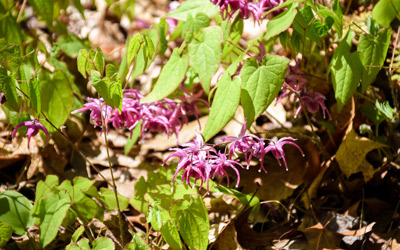
Bishop’s hat (Epimedium spp.)
Native to the alpine woodland areas of Japan, these large, spidery flowers come in an assortment of different colors. Each flower has four petals and eight sepals that closely resemble petals. These plants are often used as ground cover in shady areas and can tolerate dry shade when they’re established. Many of these plants can be found in the Shade Garden’s large bed.
Location(s): The Shade Garden, The Court, Cottage Garden, Lawn Garden, Entry Garden, and the Garden of Inspiration

Kousa dogwood (Cornus kousa cultivars)
These small, deciduous flowering trees or shrubs can grow anywhere from 15 to 30 feet tall. What look like flowers — showy white bracts that show up in late spring — surround a center cluster of yellow-green, true flowers. Once the flowers fade, they are followed by fruits that resemble strawberries and that mature to a pink-red color in the summer and into fall. There are multiple cultivars in the Lawn Garden as well as some weeping varieties.
Location(s): The Lawn Garden

Rhododendron (Rhododendron spp. and cultivars)
Rhododendron, lovingly known as “Rhodies,” are a genus of woody plants native to Asia, North America, Europe, and Australia. They grow in temperate deciduous forests often along hillsides and mountain slopes. Rhododendrons and azaleas — another flowering plant in the Rhododendron genus — can be found in bloom from early spring to fall. Looking for a difference between the two? One way is to count the stamen. An azalea will only have five stamens, while rhododendrons will have ten or more.
Location(s): From the Cottage, Lawn, Secret, Winter, and Shade Gardens to the Inner Park

Tulip (Tulipa spp. and cultivars)
The Tulipa genus has around 100 species. The perennial bulbs are a popular spring flower that can be found in just about every color except true blue. Prized during the Dutch Golden Age for their bright and varied colors, tulips were the subject of the first economic bubble in history. These large, showy flowers grow best in sunny, well-drained locations and can be found all over the Garden come May.
Location(s): All over the Garden, from the Cottage, Winter, Lawn, and Secret Gardens to the Court, Garden of Inspiration, and The Ramble
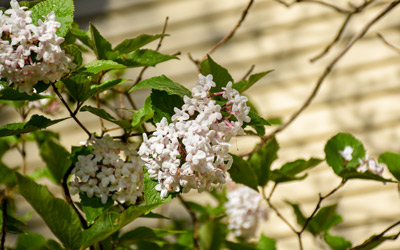
Korean spicebush (Viburnum carlesii and cultivars)
These slow growing, rounded, deciduous shrubs typically mature to be four to five feet tall, but depending on the variety and garden conditions can reach up to eight feet in height. The shrub’s reddish buds open white in early to mid-May. The flowers, arranged in snowball-like clusters, are extremely fragrant. Berry-like drupes take the place of blooms in late summer, and the foliage takes on red hues in the fall.
Location(s): The Cottage, Entry, and Secret Gardens, and the Garden of Inspiration
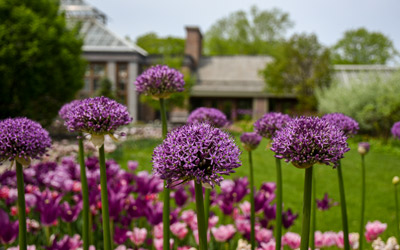
Ornamental onion (Allium spp. and cultivars)
Over 700 species can be found within the Allium genus. The unique bulbs of this genus produce flowers and foliage that have an oniony smell. The purple-pink flowers of these plants show up after the green leaves die back in the spring. Flowers, more than thirty per stem, grow in a ‘starburst’ or globe-like shape on a single stem. Some species are grown for culinary purposes while others are cultivated for ornamental purposes.
Location(s): The Lawn, Secret, and Winter Gardens, and the Garden of Inspiration

Iris (Iris spp. and cultivars)
There are around 300 species of plants in the Iridaceae family, including some of the most popular flowers known worldwide. Irises can either be bulbous or rhizomatous, but those native to the southwestern parts of Europe typically produce bulbs. Most iris flowers produce three sepals, three petals, and three stigma branches. There are many species of Iris found throughout the Garden including bearded iris (Iris germanica), Japanese iris (Iris ensata), and Siberian iris (Iris sibirica). All three species bloom late May into June.
Location(s): Along the Perennial Path in the Lawn Garden and in the Garden of Inspiration

Common lilac (Syringa vulgaris cultivars)
These multi-stemmed, deciduous shrubs are part of the olive family. Native to the open woodlands and rocky hills of southeastern Europe, the common lilac has been widely cultivated throughout Europe and North America. The single or double, white, lavender, light to dark purple flowers bloom in conical or pyramid shaped clusters and are known for their extreme fragrance. While not native to the United States, common lilac is the state flower of New Hampshire.
Location(s): Beside the Vegetable Garden, in the Secret and Lawn Gardens, and the Garden of Inspiration
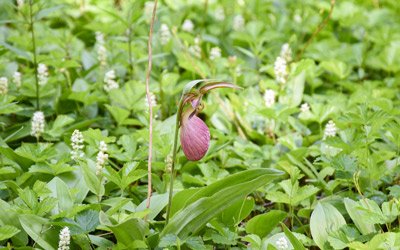
Pink lady’s slipper (Cypripedium acaule)
These large, showy wildflowers belong to the orchid family. The plant has two opposite basal leaves with a large flower at the end of a stalk. Lady slipper flowers range from magenta to whitish-pink and can have darker pink veins. Native to most of the eastern United States, they live in a wide array of habitats from mixed hardwood forests to rocky and mossy slopes and more. The flowers often bloom between May and July.
Location(s): Woodlands and naturalistic spaces
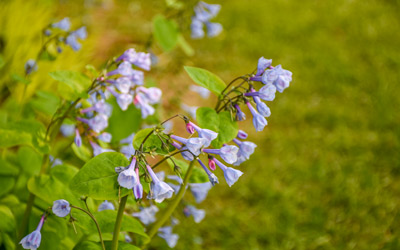
Virginia bluebell (Mertensia virginica)
A stunning eastern North American ephemeral with crisp green foliage and beautiful cerulean blossoms, Virginia bluebell grows in most soils. The flower buds are pink and the blooms emerge with a pinkish hue before turning blue. The plant is great for the shade garden and forest floor plantings.
Location(s): The Cottage Garden and Inner Park
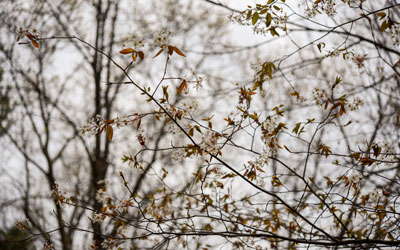
Serviceberry or shadbush (Amelanchier canadensis)
Native to New England, you are guaranteed to see this tree flowering along roadsides. These shrubs bloom in early May, producing quarter to half dollar-sized flowers that give off a slight fragrance. The flowers later turn into bright crimson berries which wildlife flock to. This plant is a great native substitute for the Bradford Pear.
Location(s): The Inner Park and Shade Garden
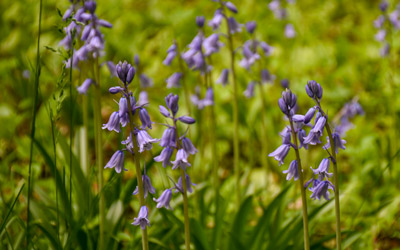
Spanish bluebell (Hyacinthoides hispanica)
This bulbaceous perennial produces pale blue bell-shaped flowers in spring, usually blooming in mid to late May. Native to the Iberian Peninsula, Spanish bluebells have become naturalized in the United States and are commonly cultivated. The flowers provide a pop of color and contrast in woodland garden areas and prefer dappled sunlight and moist, well-draining soil.
Location(s): The Shade Garden
